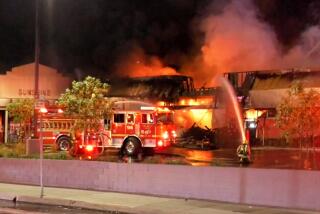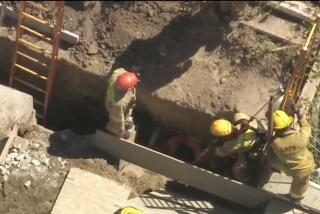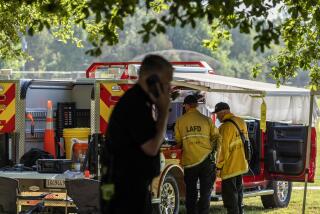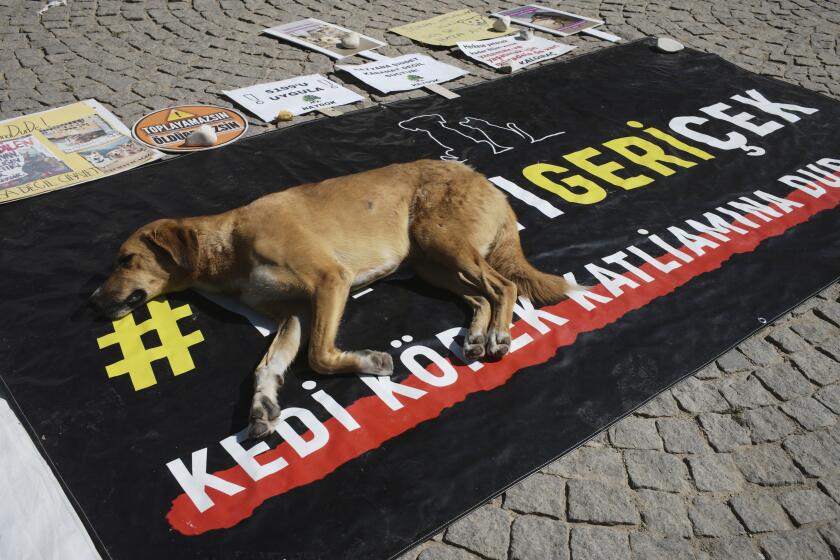ARCHIVE: A family of firemen torn at its heart
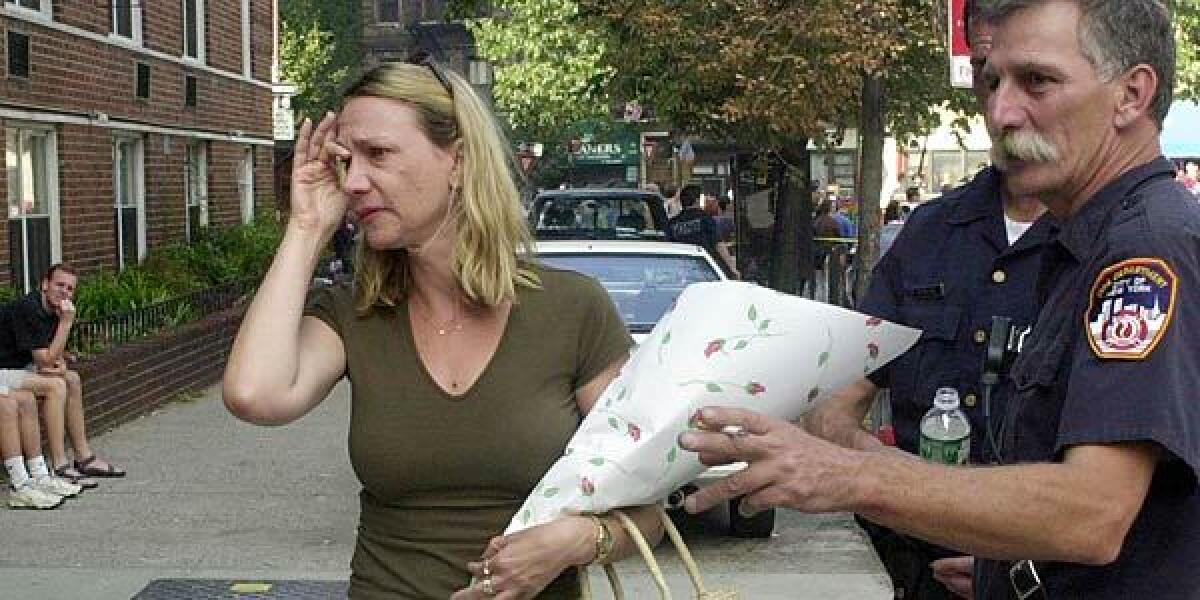
Mike Warchola had two more shifts before he would retire. Greg Saucedo was studying hard to make lieutenant. And Johnny Santore--could anyone say enough about lovable Johnny, the fireman with the thick, black mustache who played Santa every year at the Christmas party? These men and five others of Ladder No. 5 company had trudged up a stairwell of the north tower of the World Trade Center--and apparently into the fireball.
One-third of the company is missing, an apocalyptic tragedy in a firehouse where men call one another “brother” and live together like family.
Tuesday night, the surviving brethren dug with their hands through metal, plaster and mounds of rubble, looking for their brothers near their smashed ladder truck. They used hooks and shovels to clear debris. But nothing worked like their hands, and they dug until they were raw.
But though they uncovered a dead woman and hissing oxygen masks and cleared their big rig enough to move it, they never found Mike, Andy, Lou, Tommy, Vince, Greg, Paulie. And of all the great guys in a great house, they didn’t find smiling Johnny Santore.
“Everyone was hoping to find someone alive and pull him out,” said Stephen Sullivan, a retired member of No. 5 on the scene. “You hope. But you’re afraid too, of what you’ll find.”
Sullivan could not hold back tears Wednesday as he waited to hear about the missing. At 56, he is still fit. He is grayed by years on a hard job, but there is still a sparkle in the man.
“I went to John’s wedding,” Sullivan said.
He wanted to explain how they were family, so he turned to the bulletin boards on the third floor of the firehouse. Look at the pictures, he said, pointing to four huge bulletin boards plastered with small snapshots of the guys from Ladder No. 5 and Engine No. 24, which share the house on 6th Avenue at West Houston.
These are grinning, athletic, wholesome men. They are loved in the neighborhood because they fix
leaky bathtubs in the middle of the night and know all the kids’ names and rescue the kitchen help when they almost burn up the corner diner.
They do not have the complications police officers do, not knowing sometimes who the enemy is. They run into fires. It isn’t for the money. They earn far less than the Wall Streeters in the neighborhood, but more than those who clean up the buildings. They’re good guys, men who like their rituals--hosing down the rigs, roll calls in front of the station house and a few beers after work.
Sullivan pointed to a photograph of Johnny Santore wearing a red ribbon and a medal around his neck. Frances, his wife, and their two girls are next to him, smiling. There’s Johnny again, horsing around with new recruits. And Johnny in a red Santa Claus suit.
“We cook together, we eat together, we sleep together,” Sullivan said.
On the first floor where the trucks are parked, Sullivan came across four pairs of black leather shoes neatly lined up against a wall.
“Who’s gonna fill those shoes?” he asked. And then he cried some more.
The men of No. 5 and No. 24 were among the first to respond to Tuesday’s suicidal plane attack. They pulled their trucks, both brand-spanking new, out on West Street, right up to the north tower, and headed up the “A” stairwell.
Unlike most who could only imagine what it was like in that unspeakable inferno, these firefighters know what their friends must have gone through. They felt the heat, smelled the gas, saw the orange flames and choked on black smoke. They were in the darkness, they heard shrieks.
“We made it up 37 floors carrying a lot of heavy equipment,” said Marcel Claes of Engine No. 24, “and we got an urgent message to come right back down. I think the Ladder 5 guys may have proceeded up farther.”
Claes got separated from his buddies on the sixth floor. He was directed to another stairwell. “I manned my rig as the pump operator, but we ran out of water.” Before he could get more water, he was told to get out of the area, and he ran alone from the falling building. It wasn’t until he got back to the firehouse much later that he heard about all the guys who were unaccounted for.
Frank Coughlin, No. 5’s captain, had his remaining men at the scene most of Wednesday as part of the rescue mission. But at the same time they were doing their job, they all were listening to police and fire radio reports of firefighters who might be alive in the rubble.
“We’ll have members at that scene until we bring all our guys home,” Coughlin said.
Home is the firehouse, where all day Wednesday the missing men’s families called constantly and just showed up.
Paulie Keating’s sister, Jeanne, introduced herself to Frances Santore.
Together, they watched a parade of volunteers bring in food: 30 pies, towers of pizza boxes. They also brought in desperately needed clean clothes--mounds of white socks and T-shirts--for the grimy, soot-laden firefighters.
“I hear John is not only the most senior guy, but the best guy in the house,” Jeanne said. She was careful to use the present tense.
Frances tightened her black jacket closer to her body and just shook her head.
“Yeah, yeah, he’s a good guy,” Frances said.
They made small talk about neighborhoods and high schools in Staten Island, where most of the firefighters in this house grew up and now lived.
“We’re still living there,” said Frances, attempting a smile.
Tommy Hannafin’s four brothers showed up in the late afternoon. At one point, word came that Tommy was taken off the “missing” list kept by the firefighters’ union. It was unclear exactly what that might mean.
Mayor Rudolph W. Giuliani, wearing a New York Fire Department cap, announced at a news conference that as many as 300 of the city’s 9,000-member force were missing. Among them were the men of Ladder No. 5: Lou Arena, Vince Giamonna, Andy Brunn, Mike Warchola, Greg Saucedo, Paulie Keating, Tommy Hannafin and Johnny Santore.
It already had been disclosed that several top fire department officials had been killed. Also on the list is the Rev. Michael Judge, a fire department chaplain who was giving last rites to a firefighter when he too was buried by debris.
“You gotta hold on and hope,” Capt. Anthony Varriale told the Hannafins. The brothers, with their blond crew cuts and bloodshot eyes, hugged one another in the bright afternoon sun outside the firehouse.
Above them, the firehouse’s American flag flew at half-staff.
Varriale, a small, round-faced fireman, watched them but had to avert his eyes after a few minutes. He was not convinced there would be firefighters walking out of that mess on the tip of Manhattan. He had been through tragedy in 1994, this station’s worst, when three guys died in a townhouse fire. This was so much bigger; there were so many more bodies to dig out.
“People don’t survive very long under mounds of concrete,” Varriale said. “But we’ll keep waiting until there’s no more hope.”
More to Read
Sign up for Essential California
The most important California stories and recommendations in your inbox every morning.
You may occasionally receive promotional content from the Los Angeles Times.
